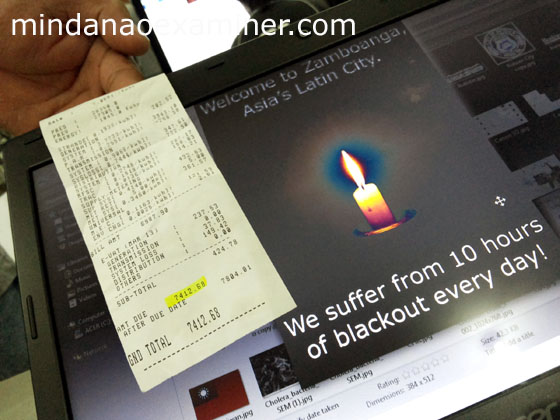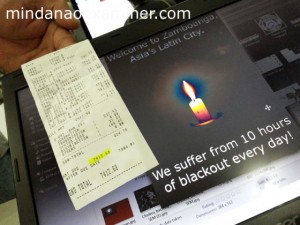
The Zamboanga City Electric Cooperative said it now charges P7.0881 per kilowatt hour for residential consumers and P6.6040 for commercial users. Previous rate was just a little over P6.
“I don’t know why we have to pay this much considering the long hours of blackout in Zamboanga. We should be paying less, now who shall we blame?” asked Jeng Fernandez, a business woman.
Vic Liozo, a board member of the Zamboanga City Electric Cooperative, said there is a shortage of electricity not only in Zamboanga, but the whole of Mindanao due to the decreased level of water in dams used in hydro-power facilities.
The National Grid Corporation of the Philippines has also blamed the low water level and routine maintenance in hydro-power plants in Mindanao as the culprit for the lack of power supply. And with this problem, big power producers take advantage of the situation and offer alternative, but expensive solutions diesel-fed power barges and dirty coal-fired power plants to provide more electricity supply.
The Department of Energy said power consumers may have to pay more if electric cooperatives would resort to using modular generator sets and power barges in Mindanao to help augment the much needed power supply in the region.
General Santos City is also suffering from four hours of blackout every day, and also six to eight hours in Pagadian City in Zamboanga del Sur province, and also in Sulu and Tawi-Tawi provinces. Basilan province is dependent on power barges for electricity supply.
Mindanao was hit by repeated power crises in the past and nothing has been done by the government except to promote the use of coal-fired power plants. But this too, comes with a price and that translates to huge electric bills.
Liozo said Zamboanga City’s power consumption is 85 megawatts, but it is just getting about 35 megawatts of electricity from the National Power Corporation. The long hours of blackout are affecting both residential and commercial consumers and there is no tangible solution in sight, not until 2016 when the 100-megawatt coal-fired power plant of the Alsons Power Holdings begins operations in the village of Talisayan.
But villagers are strongly opposed to the operation of the coal-fired power plant due to the pollutions and its effects to the human health and environment. A 10-megawatt solar power facility is also being built in Zamboanga to augment the 90-megawatt electricity requirements of the city.
The local power cooperative signed a contract with the Aboitiz-owned Therma Marine Inc. for an additional 18 megawatts of electricity, but despite this the city still suffers from daily power outages from six hours to as much as ten hours.
Now the Therma Marine Inc. has to refund to the power cooperative the amount of P14, 252,557 following a decision by the Energy Regulatory Commission.
According to the Zamboanga Chamber of Commerce and Industry Foundation, the decision was based on the difference between the final and the provisionally approved rate starting from the implementation of provisional authority until the effective implementation of the final electricity rate for Zamboanga City.
The Zamboanga City Electric Cooperative purchased electricity in 2012 from TMI, but it paid more and the now has to be refunded based on the final electric rate decided and approved by ERC.
TMI may apply the refund or a portion of it to any outstanding obligation Zamboanga City Electric Cooperative and the remaining amount over a period of 12 months.
The interveners in this case were the local government, the Industrial Group of Zamboanga, the Employers’ Confederation of the Philippines (Zamboanga, Basilan, Sulu Tawi-Tawi chapter) and the Zamboanga Chamber of Commerce and Industry Foundation, Inc.
The organizations were represented by lawyers Bernardino Ferrer, Carl Andrew Rubio, Edgar Lim, and Pedro Rufo Soliven, of the Zamboanga Chamber of Commerce and Industry Foundation, Inc. (Mindanao Examiner)

